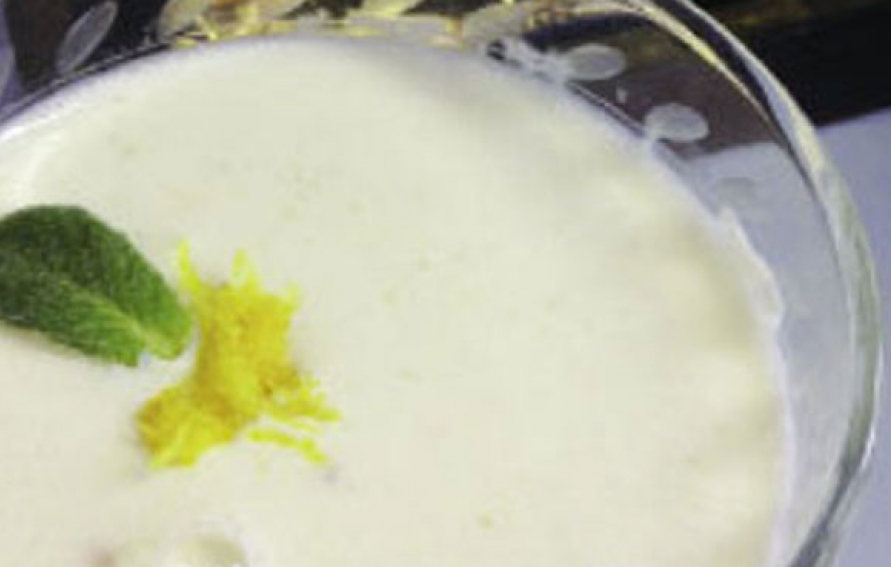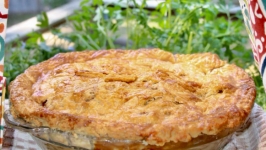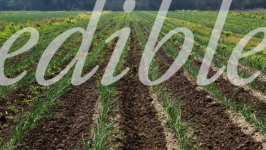Ingredients
- ¾ cup Irish moss
- 4 cups milk
- salt
- ½ teaspoon lemon or vanilla
- sugar and cream
Instructions
Soak seaweed in cold water for 30 minutes or so, rinse and tie in cheesecloth. Put in top of double boiler. Cook, covered, for 30 minutes. Remove bag and add vanilla or lemon and a little sugar. Pour into bowl and chill until firm.
Serve with sugar and cream.
About this recipe
When a group of men from the Massachusetts Agricultural Society were surveying Cape lands during the 1800s, they referred to the use of seaweed in Cape agriculture as “the refuse of the sea cast upon the shore and collected by local people to fertilize their poor soils for lack of anything better.” Today, the benefits of seaweed as a fertilizer are highly acknowledged worldwide. Their ability to concentrate minerals and trace elements from the sea render them a potent source of nutrients. Here in New England seaweed has almost exclusively been used as fertilizer or animal fodder throughout history, with little use as human food.
In the 1870s some unusual sheep production took place on isolated islands off the New England coast. The islands contained little shelter except for scrubby evergreens, and because the winds continuously swept the grazing fields free of snow, it was usually unnecessary to provide winter feed. The principal food for these wild sheep was a variety of seaweed called dulse found on the shore during high tides. Feeding sheep seaweed was probably a tradition brought over by the early colonists. Meat from the island sheep was reputed to resemble venison rather than mutton in flavor and it was in great demand in the northeast. Here on the Cape, seaweed was gathered and piled against foundations for insulating houses during winter, and come spring, was spread out onto gardens and fields as fertilizer and mulch.
Although it is believed that seaweed has been used as a food since 2700 B.C., it has never been considered a staple in our culture. Ancient writings from 600 B.C. China spoke of seaweed being served to special guests and kings. The edible bird nests of China, so prized as a delicacy even today, are a strange and exotic form of eating seaweed. The nests are chiefly composed of seaweed and are formed by a swallow from gelatinous algae, which are eaten and then disgorged by the birds in building their nests.
Closer to home, in Ireland, Scotland and England, North Atlantic seaweeds have been used by coastal dwellers for at least 4000 years as food, fertilizer and animal fodder, its earliest recorded account from a poem dated A.D. 563 and attributed to Saint Columba, a native of Donegal, Ireland. It has been an important dietary supplement in times of need such as the great potato famine and it was also very important to the poor and those displaced from their farmlands during the late 1700s to make way for the grazing of sheep. Eventually a few colonists, and later immigrants of Irish and Scottish descent, did bring their traditions of culinary and medicinal seaweed use to New England.
When early colonists arrived on New England’s shores they found many of the same Atlantic seaweeds here that were used as food in Scotland and Ireland such as dulse (Palmaris palmate), Irish moss or carrageen moss (Chondrus crispus), purple laver (Porphyra umbilicalis), and green laver (Ulva lactuca). In the Old Country, seaweeds had great importance. Red or purple dulse, also referred to as “leaf of the water” or dillesk, was used both for food and medicine. It was traditionally eaten with oatmeal in a thick broth or served boiled and tossed in butter in Ireland. It was sold in the streets and the poor “fisher folks” along the wild coasts prized it as a relish with their dry potatoes and salt fish. It was prepared by washing it well in fresh water and spreading it out in the sun to dry. A sweet white powder predominately made up of sodium-based minerals known as mannite, would gather on the fronds (sold as “sugar kelp” in Ireland today), which is very agreeable in taste. When this white powder appeared the dillesk was ready for sale and was packed in bags or casks for winter use. Irish and Scottish people would eat it dry. In the seacoast towns a dillesk-woman was always found seated in her market street stall with her bag of dry purple-red dulse sprinkled with glistening mannite, selling handfuls at a time.
A similar seaweed, said to be merely a small and more colorful variety of dulse, that grows below tide-level was dried and sold as having great medicinal powers. Highland women steeped the dulse in water, and drank it as a remedy for fever and glandular swellings, owing to the large amount of iodine it contained.
A very interesting seaweed that was also very popular was the long brown Laminaria, known in former days to fishermen’s children as “sea-girdles”, “lady’s ribbons”, and “donkey’s tails”. The stems are so full of iodine that they were sold around the world as “iodine sticks”. In Scotland the young leaves and stems were claimed to be extremely wholesome and were boiled and eaten. But, by far, its most interesting use was as a barometer. The woody stem, with its fringe of long brown leaves, was hung up in the cabins of the fisher-people, where it was said to show the approach of rain by becoming soft and moist.
Fucus (Fucus vesiculosus) was one of the commonest and most useful seaweeds, for its seed and air-vessels were reputed to be so full of oil that it was highly beneficial to delicate and rheumatic people. It was the original source of iodine and extensively used to treat iodine deficiency-related illnesses.
Laver, known as “sloke” or “slokaun”, was largely used as a substitute for vegetables. Many thought it a great delicacy, but its flavor and appearance seemed so peculiar that not everyone liked it. There are two kinds of laver, the purple Porphyra, esteemed by epicures, which boils to a dark brown hue, and the green Ulva lactuca or “sea-lettuce”, which is more common and more easily obtained than the purple laver, but with a less delicate flavor. Both kinds are cooked in the same way, stewed for hours in fresh water until they become liquid, and then served with butter, pepper, lemon juice, or vinegar. In many old Irish houses there were small silver saucepans in which the sloke was sent to table. Potatoes and roast mutton were said to be the best accompaniments to this dish, but English people sometimes cooked laver with onions, and it was also pickled with oil and vinegar. During the autumn and winter it was sold in most Irish towns near the sea and in the west of England. Purple laver, a traditional ingredient of Welsh laverbread, remains its key ingredient in Scotland and Ireland today.
Irish moss or carrageen moss, by far the most tasty seaweed, continues to be lightly harvested for food in Ireland, Scotland, on the coasts of England and more recently Canada and the U.S. In days past it was recommended for delicate people, as it was claimed to be strengthening and easily digested. It was made into jelly or blancmange, being boiled for some time in water, strained and boiled up again with milk, spice, sugar and lemon peel. It thickens milk as gelatin or cornflour does, and at one time was ordered by doctors in cases of throat and chest complaints. Its reddish-purple or green fronds, forked and frilled, were spread in the sun to dry and bleach, and afterwards packed in bags and sent off for sale. Masses of Irish moss, bleached and dried white by sun and strong sea air, were often found spread on the grassy headlands along the coasts of Scotland and Ireland.
Quite early in New England’s history articles were published mentioning Irish moss as a common household remedy. By the mid 1800s it was commonly used as a food additive. It also was eaten as a relish; consumed fresh or dried; boiled with milk, sugar and spices as a pudding or healthy drink; cooked in butter and served as a vegetable with meat or fish; or added to stews. It was used as an emulsifier for cod fish oil, and made into jellies for sick patients, as well as fillings, icings, meringues, glazes and marshmallows, and as a clarifying agent in beer. Today it is a source of carrageenan, commonly used as a thickener and stabilizer in milk products like ice cream and luncheon meats.
My grandmother had a seaweed recipe, passed down through generations, in her handwritten family recipe book. My mother Christine used to send my sister, brother and me to the beaches here on the Cape when we were children to collect Irish moss after storm tides and told us how she and my grandmother, Helen Wadsworth, collected seaweed when she was a girl on the beaches of Duxbury and Plymouth. Helen was a decedent of Christopher Wadsworth, who, I discovered while writing this article, sailed into Boston on September 16, 1632, onboard the ship Lion and settled in Duxbury, Massachusetts.
I wondered why my family was familiar with the culinary use of seaweeds, and asked my mother if she knew where our Wadsworth ancestors lived in England. She didn’t but told me that as a child she was taught to recite the names of her Wadsworth antecedents. She also said that Christopher had arrived on the second ship. I asked, “What ship?” which began my discovery of where my English ancestors lived and if it was a place where they may also have had the opportunity to collect Irish moss.
This direct line of Wadsworths, Helen’s father Seaborn (born at sea in the Bay of Bengal), back through Alexander (captain of the ship Seth Sprague), Ahira, Senica, Waite, Alisa, Joseph and Christopher (who was born in England to Thomas Wadsworth of Kent), did most likely walk the shores of Kent, a seaside town, collecting Irish moss themselves, and ate this same Irish moss pudding recipe that my granddaughter, daughter and I are eating today, 14 generations later.
My sister and I remember the delightful feel of the Irish moss, the color and the smell but we hadn’t actually eaten any for years. Irish moss is only found washed up on the beach during summer so we acquired some dried Irish moss from Maine and whipped up a batch. Tossed up it’s not the best seaweed to use, unless perhaps right after a strong storm, as fresh is best. Sustainable harvesting is preferred. There are some suppliers now selling North Atlantic seaweeds under the guise of “Sea Vegetables”. I purchased mine from a company called Maine Coast Sea Vegetables.
Here is my grandmother’s recipe…








